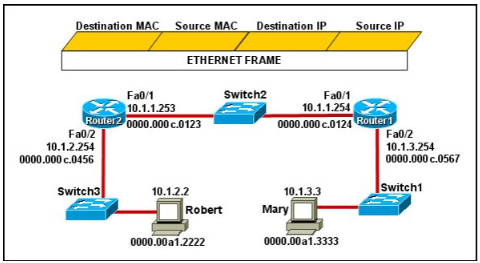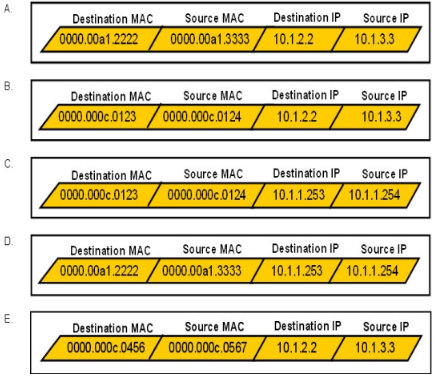READ Free Dumps For CISCO- 100-105
| Question ID 14431 | Refer to the exhibit.

Mary is sending an instant message to Robert. The message will be broken into a series of
packets that will traverse all network devices. What addresses will populate these packets
as they are forwarded from Router1 to Router2?

|
| Option A | Option A
|
| Option B | Option B
|
| Option C | Option C
|
| Option D | Option D
|
| Option E | Option E
|
| Correct Answer | B |
Explanation Explanation: The Source and Destination IP address is not going to change. Host 1 IP address will stay as being the source IP and the Host 2 IP address will stay the destination IP address. Those two are not going to change. For the MAC address it is going to change each time it goes from one hope to another. (Except switches... they don't change anything) Frame leaving HOST 1 is going to have a source MAC of Host 1 and a destination MAC of Router 1. Router 1 is going to strip that info off and then will make the source MAC address of Router1's exiting interface, and making Router2's interface as the destination MAC address. Then the same will happen... Router2 is going to change the source/destination info to the source MAC being the Router2 interface that it is going out, and the destination will be Host2's MAC address.
| Question ID 14432 | How does a switch differ from a hub?
|
| Option A | A switch does not induce any latency into the frame transfer time.
|
| Option B | A switch tracks MAC addresses of directly-connected devices.
|
| Option C | A switch operates at a lower, more efficient layer of the OSI model.
|
| Option D | A switch decreases the number of broadcast domains.
|
| Option E | A switch decreases the number of collision domains.
|
| Correct Answer | B |
Explanation Explanation: Some of the features and functions of a switch include: A switch is essentially a fast, multi-port bridge, which can contain dozens of ports. Rather than creating two collision domains, each port creates its own collision domain. In a network of twenty nodes, twenty collision domains exist if each node is plugged into its own switch port. If an uplink port is included, one switch creates twenty-one single-node collision domains. A switch dynamically builds and maintains a Content-Addressable Memory (CAM) table, holding all of the necessary MAC information for each port. For a detailed description of how switches operate, and their key differences to hubs, see the reference link below. Reference: http://www.cisco.com/warp/public/473/lan-switch-cisco.shtml